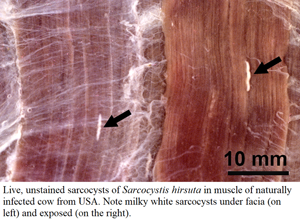Article contents
Redescription, deposition of life-cycle stage specimens of Sarcocystis bovifelis Heydorn, Gestrich, Mehlhorn and Rommel, 1975, and amendment to Sarcocystis hirsuta Moulé, 1888
Published online by Cambridge University Press: 04 August 2022
Abstract

There is considerable debate concerning the life cycles and taxonomy of Sarcocystis species in cattle. Of the 8 species of Sarcocystis named from cattle, 2 (Sarcocystis cruzi and Sarcocystis heydorni) are morphologically distinctive because their sarcocysts are microscopic and the sarcocyst wall is thin (<0.5 μm thick). The sarcocysts of the remaining species (Sarcocystis hirsuta, Sarcocystis hominis, Sarcocystis bovini, Sarcocystis bovifelis, Sarcocystis sinensis, Sarcocystis rommeli) have thick (5–8 μm) walls indistinguishable by light microscopy, alone. To provide needed clarity, I herein review the history, nomenclature and life cycle of S. bovifelis (originally named by Heydorn and associates from Germany), redescribe it and deposit specimens of its various life-cycle stages at a museum for future reference. I also provide means to distinguish this parasite from S. hirsuta. Cats are the definitive hosts for both S. bovifelis and S. hirsuta. The sarcocysts of S. bovifelis are microscopic, its sarcocyst wall is type 10g, it has 2 schizogonic stages in blood vessels and sarcocysts are formed between 25 and 30 days post-inoculation in striated muscles, but not in the heart. Sporulated oocysts are 17.1 × 12.7 μm and sporocysts are 12.8 × 8.4 μm. The sarcocysts of Sarcocystis hirsuta are macroscopic, up to 7 mm long, its wall is type 18. Nothing is known of the development of S. hirsuta in cattle tissues and in cat intestine. Size of its oocysts and sporocysts is uncertain.
- Type
- Research Article
- Information
- Creative Commons
- This is a work of the US Government and is not subject to copyright protection within the United States. Published by Cambridge University Press.
- Copyright
- Copyright © United States Department of Agriculture, 2022
References
- 4
- Cited by





